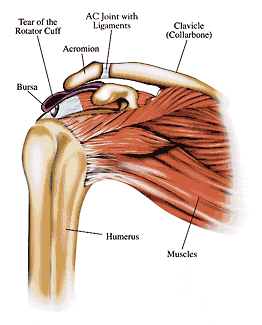
The upper shoulder consists of the humerus, calavicle, acromion, along with the various muscles, tendons, and tissues. It is a common misconception that the rotator cuff is a single entity. In fact, tears can occur within several areas of the shoulder region. Overuse and poor pitching mechanics can contribute to problems within this joint. Both the elbow and shoulder joints are particularly susceptible to injury due to growth plates that are not completely sealed or that have not gained physical maturity.

A major source of pain in younger pitchers comes from strain and/or
separation within the Growth Plate (medial apophysis). The muscle and tendons in this region connect the ulna
to the humerous. The elbow joint is a series of tendons, muscles, and
ligaments that allow the lower arm to flex or contract to the shoulder
area. In addition, the forearm muscles allow the hand to rotate and the
fingers to contract and spread apart. The elbow is relatively small
when compared to the knee joint and therefore is more susceptible to
injury through repetitive high velocity pitching.
The following links provide additional information pertaining to injury from overuse and/or incorrect pitching mechanics:
| The causes of Little League Elbow |
http://espn.go.com/trainingroom/s/2000/0426/503111.html |
| American Academy of Pediatrics |
http://www.aap.org/pubserv/sportsmed.htm |
| American Academy of Orthopaedic Surgeons |
http://orthoinfo.aaos.org/topic.cfm?topic=A00328 |